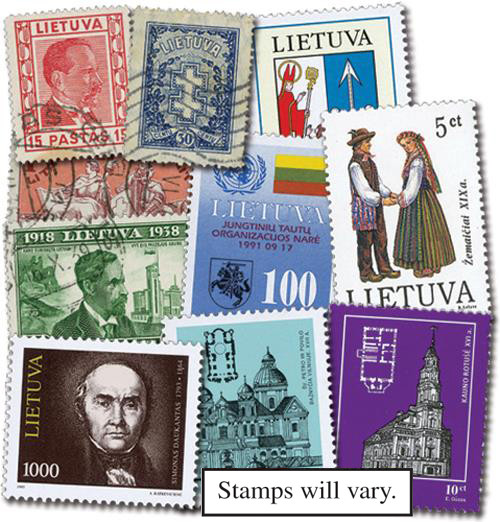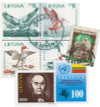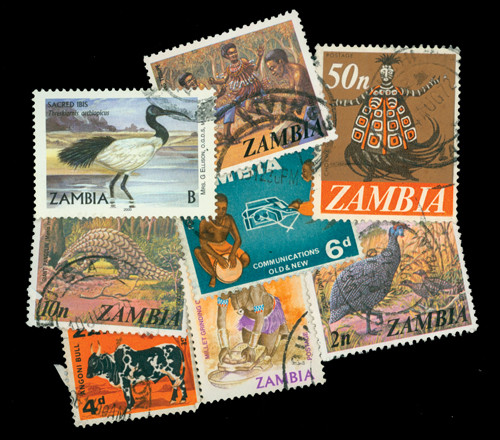
# M8521 - Lithuania, 50 Different Stamps
Expand Your Collection with 50 Lithuania Stamps
With one easy order, add 50 Lithuania stamps to your album. You'll discover the people, events, and culture of this great nation. Selections vary, but the one I looked through contained symbols of ancient Lithuania; heraldry and coat of arms. There were also reflections of the emerging modern nation, including an airmail stamp. I also saw stamps issued after the country’s transition to a newly independent nation that pictured Pope John Paul II, frogs, turtles, art masterpieces, native costumes, architecture, historic national symbols – even a souvenir sheet honoring an ancient king.
Fun and historic, Lithuania’s stamps belong in your worldwide collection.
More About Lithuania…
Although people lived in the area of what is present-day Lithuania as far back as 8,000 B.C., the first written record of people in the region dates from around 100 A.D. Tacitus, a Roman historian told of these inhabitants selling amber to the Romans. These same people united into a single nation in the late 1100’s.
By the early 1200’s Lithuania was in the midst of fighting off a group of crusaders from Germany called Teutonic Knights. Not only was this invasion unsuccessful, Lithuania actually grew stronger in the coming years. By the mid 1300’s Lithuanian borders extended almost all the way to Moscow in the east and to the Black Sea in the south. In 1386 Grand Duke Jagiello united Lithuania and Poland. For the next 186 years these countries functioned as two states under the same king. Then, in 1569 they were made into a single state.
Following the collapse of the Lithuanian-Polish government, the Czar of Russia took over rule of Lithuania. The citizens rebelled against the Russian government twice, once in 1831 and again in 1863. Although these attempts were unsuccessful, they greatly angered the Czar. He tried to increase Russian influence on Lithuania by closing Lithuanian schools and banning Lithuanian literature. Lithuanian culture remained alive and strong though, as parents continued to teach their children at home. During this period, many Lithuanians immigrated to the United States.
By 1880 the move toward independence had already begun. In 1905 a Lithuanian plan for self-government was rejected by Russia. During World War I Lithuania was occupied by German troops, until on February 16,1918, it became the first Baltic State to declare its independence from Russia and Germany.
Lithuania’s new government was a democracy in which the parliament had power over the president. Land was redistributed among all citizens and a new educational system was established. All was not smooth sailing for the fledgling country. Following World War I Russia tried unsuccessfully to take over Lithuania. From 1920 to 1939 Poland occupied the capital city of Vilnius, gradually taking more control of the country. In 1939 Germany seized a portion of Lithuania, despite attempts at resistance. Later that same year Germany and the Soviet Union signed an agreement giving the Soviet government control of the entire Baltic region. Lithuania remained part of the Soviet Union for the next 50 years.
Expand Your Collection with 50 Lithuania Stamps
With one easy order, add 50 Lithuania stamps to your album. You'll discover the people, events, and culture of this great nation. Selections vary, but the one I looked through contained symbols of ancient Lithuania; heraldry and coat of arms. There were also reflections of the emerging modern nation, including an airmail stamp. I also saw stamps issued after the country’s transition to a newly independent nation that pictured Pope John Paul II, frogs, turtles, art masterpieces, native costumes, architecture, historic national symbols – even a souvenir sheet honoring an ancient king.
Fun and historic, Lithuania’s stamps belong in your worldwide collection.
More About Lithuania…
Although people lived in the area of what is present-day Lithuania as far back as 8,000 B.C., the first written record of people in the region dates from around 100 A.D. Tacitus, a Roman historian told of these inhabitants selling amber to the Romans. These same people united into a single nation in the late 1100’s.
By the early 1200’s Lithuania was in the midst of fighting off a group of crusaders from Germany called Teutonic Knights. Not only was this invasion unsuccessful, Lithuania actually grew stronger in the coming years. By the mid 1300’s Lithuanian borders extended almost all the way to Moscow in the east and to the Black Sea in the south. In 1386 Grand Duke Jagiello united Lithuania and Poland. For the next 186 years these countries functioned as two states under the same king. Then, in 1569 they were made into a single state.
Following the collapse of the Lithuanian-Polish government, the Czar of Russia took over rule of Lithuania. The citizens rebelled against the Russian government twice, once in 1831 and again in 1863. Although these attempts were unsuccessful, they greatly angered the Czar. He tried to increase Russian influence on Lithuania by closing Lithuanian schools and banning Lithuanian literature. Lithuanian culture remained alive and strong though, as parents continued to teach their children at home. During this period, many Lithuanians immigrated to the United States.
By 1880 the move toward independence had already begun. In 1905 a Lithuanian plan for self-government was rejected by Russia. During World War I Lithuania was occupied by German troops, until on February 16,1918, it became the first Baltic State to declare its independence from Russia and Germany.
Lithuania’s new government was a democracy in which the parliament had power over the president. Land was redistributed among all citizens and a new educational system was established. All was not smooth sailing for the fledgling country. Following World War I Russia tried unsuccessfully to take over Lithuania. From 1920 to 1939 Poland occupied the capital city of Vilnius, gradually taking more control of the country. In 1939 Germany seized a portion of Lithuania, despite attempts at resistance. Later that same year Germany and the Soviet Union signed an agreement giving the Soviet government control of the entire Baltic region. Lithuania remained part of the Soviet Union for the next 50 years.










